1. Introduction
Heating poses both challenges and opportunities for urban areas in relation to social and environmental sustainability. Under China’s space heating policy, cities in Southern China do not have access to central heating. In the absence of central heating, the comfort of indoor environments in old neighborhoods awaiting urban renewal is poor. Residents are forced to rely on local electric heating, which is usually expensive, inadequate, and inefficient [1]. A recent survey by the author, of thirty residents randomly sampled from old Shikumen communities and public housing estates in downtown Shanghai indicated that there is a notable heating demand in Shanghai from November to the coming February. The use of environmentally sustainable heating methods is also found to be very limited (Figure 1). Major issues with current heating methods, included high energy costs, air-conditioning being too dry, and poor heating performance from appliances (Figure 2).
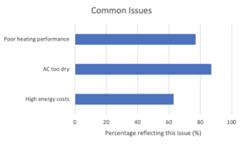 | 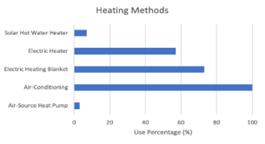 |
Figure 1. Heating methods used by Shanghai residents (results from the survey) | Figure 2. Common issues with heating methods reflected by residents (results from the survey) |
Nie et al. [2] showed that the average indoor temperature in Shanghai during winter is around 17 °C , below the advised range of 20-21 °C for comfort; 91% of residents surveyed in their study often or occasionally felt cold indoors during winter.
The built environment is responsible for 37% of global CO2 emissions; heating is a major source of energy consumption [3]. This has led the UN Environmental Program (UNEP) to recommend the development of “sustainable, zero-carbon and resilient” structures that are conscientious of their environmental footprint [4]. Transforming energy systems in urban areas has become crucial to strategies seeking to reduce carbon emissions in many countries. Heat pumps have been identified as a promising candidate in this sustainable revolution: they are 3-5 times more efficient than gas boilers and can offset 500 million tons of CO2 emissions by 2030 [5]. Air source heat pumps (ASHP) that extract heat from the external air have been recognized for their low energy consumption and ease of installation in urban areas, making them attractive replacements for fossil-fuel based systems [6]. Heating takes up 68% of the energy use of an average Chinese household, so popularizing ASHP installation in large Chinese cities has the potential to improve efficiency and drastically reduce CO2 emissions [7].
However, current ASHP systems face obstacles in becoming widely used. Being single-source heat pumps, ASHP lack versatility and stability. Cai et al. [8] suggested that a fundamental contradiction of ASHP is that their heating capacity is positively correlated to ambient temperature. This means their performance is suboptimal when heating demand is greatest during winter. Auxiliary heating is often required to meet heating demands, offsetting the environmental benefits of ASHP. Furthermore, Song et al. [9] noted that the outdoor coil of ASHP is susceptible to frost deposition in winter. Frost reduces the COP (coefficient of performance) as it obstructs airflow and increases thermal resistance between the evaporator and the air. It can also make the operation of the heat pump system unreliable and intermittent, rendering it unsuitable for domestic household usage [10]. This issue is especially pertinent in Shanghai, which is located in the heavy-frost region for 60% of its heating period [11].
Solar water heaters are commonly used in Southern China for heat supply. Despite being clean and efficient, they are also constrained by being single-sourced [12]. Jouhri and Dakar [13] noted that the efficacy of solar water heaters is restricted by the intermittent and unreliable nature of solar irradiation and heating demand. For instance, in Shanghai, irradiation is highest in May and lowest in December and January when heating demands are most pronounced [14].
This study aims to address the limitations of the above single-source systems by combining them in a solar thermal ASHP (ST-ASHP) that derives energy from two sustainable sources – air and solar irradiation. A serial indirect expansion design (IDX-ST-ASHP) is adopted where the solar collector’s cycle is separated from the ASHP’s cycle, and the refrigerant cycle of the solar collector interacts with that of the ASHP through a heat exchanger. Liu et al. [15] demonstrated that IDX-ST-ASHP exhibit enhanced performance in low-temperature conditions as the use of a secondary fluid optimizes heat transfer and reduces the risk of the refrigerant freezing or leaking.
Several experimental and modeling studies have been conducted on different IDX-ST-ASHP; however, most focus on parallel configurations where the solar thermal collector and ASHP are separately linked to the heat storage tank. Yerdesh et al. [16] found the solar collector refrigerant cycle in parallel systems ineffective during winter, as the solar irradiation of 500 w/m^2 did not allow the solar collector heat transmitter to heat the storage tank to sufficiently high temperatures. Hence, a major weakness of the parallel IDX-ST-ASHP systems is that they require a certain level of solar irradiation to produce a heating effect; when solar irradiation levels are low, the performance of the entire hybrid system is impacted. Furthermore, parallel configurations cannot increase air source temperature through coupling, so the issues of poor heating performance in low ambient temperatures and frost accumulation on evaporator coils facing ASHP are unaddressed.
This study proposes a novel hybrid IDX-ST-ASHP that adopts a serial configuration. In the novel serial configuration, coupling occurs in the heat exchanger. The source-side of the heat exchanger is the solar thermal collector, and the load-side is the ASHP evaporator. This allows energy from the solar thermal collector to improve the temperature of the ASHP air source. It is hypothesized that the hybrid design can deliver better heating performance over conventional single-source ASHP due to the synergistic effects of the two clean energy sources. The novel coupling design for the hybrid sources is anticipated to increase energy gains from the air source and reduce the risk of frost accumulation on the evaporator.
This study focuses on providing a compact, versatile, user-friendly heating solution that can be implemented in old buildings during regeneration. The large and complex systems tested by most current studies are incompatible with the requirements of urban renewal. For one, many historic structures enjoy protection status, so construction projects that are obtrusive to the building may be deemed inappropriate for conservation and thus not allowed. Even in non-protected structures, installing conventional heaters may be impossible due to structural constraints and budget overruns. The adaptable design of the novel hybrid system strives to optimize user experience, heating efficiency, and environmental sustainability, addressing the unique demands of the city’s elderly population as well as site constraints imposed by urban renewal.
2. Methods
2.1. Prototype Design and Construction
The basic design of the novel hybrid ST-ASHP system is shown in the diagram below (Figure 3). The main innovation of this prototype lies in the heat exchanger; the load-side of the heat exchanger simultaneously functions as the evaporator of the ASHP. The coupling design allows the solar thermal collector to increase the temperature of the air source, giving the ASHP better performance.
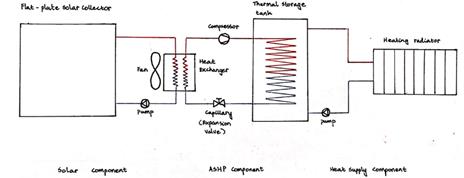
Figure 3. Schematic diagram of the novel solar-assisted ASHP (original sketch by author)
A prototype was constructed based on the above design (Figure 3). The novel hybrid system consists of three main parts: a solar thermal collector cycle which connects the solar thermal collector with the source-side of the heat exchanger; the ASHP component which contains the load-side of the heat exchanger (simultaneously posing as an evaporator), the compressor, and the condenser unit in the heat storage tank; finally, the radiator-heat storage tank cycle which connects the heat storage tank to the radiator (Figure 4 and Figure 5).
The characteristics of different components were considered in the design of the novel hybrid system. A flat-plate solar thermal collector was selected as it is cost-effective and can withstand high temperatures during the summer [17]. A fin-type heat exchanger with a counter-flow design was selected to maximize heat transfer efficiency. Counter flow heat exchangers have the inlet of the hot-side fluid corresponding with the outlet of the cold-side fluid. This allows the cold-side fluid to reach maximum temperature as it exits the heat exchanger, optimizing the efficiency of heat transfer. The tank acts as a thermal storage unit that mitigates the impact of fluctuating solar radiation throughout the day [18]. Additionally, it improves the hydronic flexibility of the heating system.
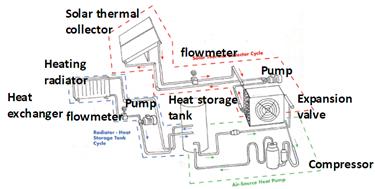
Figure 4. A simplified diagram by the author showing main components and the cycles and directions of flow in the novel hybrid ST-ASHP system
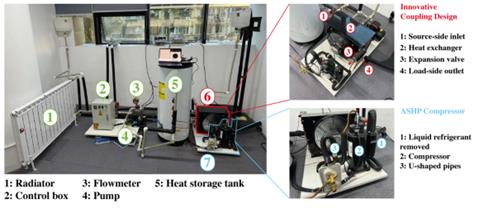
Figure 5. The indoor part of the prototype system, with the ASHP unit and the radiator-heat storage tank cycle. The solar collector is located on the balcony outside (photos by author)
2.2. Experimental Procedures
Experiments were conducted on the novel hybrid system prototype to evaluate its performance under different ambient temperatures and compare its performance in hybrid and non-hybrid modes. The procedures for these experiments are shown in the flowchart below (Figure 6).

Figure 6. Flowchart showing the methodology and experiment procedures
2.3. Monitoring Points and Calculation of Key Parameters
Monitoring points in the prototype system was shown in Figure 7.
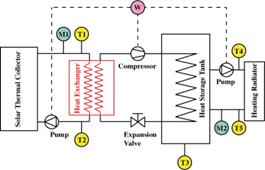
Figure 7. Monitoring points in the prototype system. Yellow indicates temperature recording points, turquoise indicates flowmeters, and pink indicates the power meter
Table 1 shows the measuring equipment used. Raw data from the multi-channel temperature recorder is recorded on a USB drive. This is combined with manually recorded power and tank temperature readings at intervals of two minutes. Initially, all the data collected is compiled into an Excel spreadsheet. Data is selected for the period of time as the tank temperature increases from 35 °C to 50 °C. This temperature range was determined for safety reasons; 50°C is also within the recommended temperature range for water used in a heating radiator. Thus, the prototype experiment is able to simulate the heating demands of residents, allowing an evaluation of the novel hybrid system’s social viability.
Table 1. Measuring equipment used
Component type | Notes |
Multi-Channel Temperature Recorder | Eight available recording channels; temperature data from the recorder can be stored on a USB drive |
Digital Power Meter | Used to measure the instantaneous power of the system |
Flowmeter | Used to measure the mass flow rate of water in the solar thermal collector cycle and the radiator cycle |
Heating rate was calculated by plotting the tank temperature ( T_3 ) against time and modeling a linear line of best fit. The gradient of the linear model gives the heating rate.
The COP of the system is also evaluated by calculating both the instantaneous and average COP of the system. COP measures the ratio of power output by a system to power input to a system. In this study, the COP value is referenced as an important benchmark for environmental sustainability. The method for COP calculation is detailed below (refer to Table 2 for nomenclature used in the equations).
Solar thermal collector energy output (per second):
Q_{solar}=m_{1}c(T_{1} - T_{2})\ \ \ (1)
Radiator energy output (per second)
Q_{rad}=m_{2}c(T_{4} - T_{5})\ \ \ (2)
Instantaneous COP:
COP_{i}=\frac{Q_{rad}}{W}\ \ \ (3)
Average COP:
COP_{a}=\frac{ \in t\ _{}^{} Q_{rad} dt}{ \in t\ _{}^{} W dt}\ \ \ (4)
Table 2. Nomenclature
Variable | Units | |
Q_{solar} | Power supplied by the solar thermal collector | W |
Q_{rad} | Power of the radiator | W |
{\rm COP}_i | Instantaneous COP | |
{\rm COP}_a | Average COP | |
m_1 | Mass flow rate of the solar thermal collector cycle | kg/s |
m_2 | Mass flow rate of the radiator-heat storage tank cycle | kg/s |
T_1 | Temperature of the heat exchanger source-side inlet | °C |
T_2 | Temperature of the heat exchanger source-side outlet | °C |
T_3 | Temperature of the heat storage tank | °C |
T_4 | Temperature of the radiator inlet | °C |
T_5 | Temperature of the radiator outlet | °C |
c | Specific heat capacity | J/kg °C |
W | Power consumption of the system | W |
The energy supplied by the solar thermal collector is calculated using temperature data from the outlet and inlet of the flat plate collector; from this, the contribution of the solar thermal collector cycle to the novel hybrid system can be found. Three sets of data were collected for different ambient temperatures. Throughout the process, comparisons between the non-hybrid and hybrid working modes of the system were measured to validate the efficacy and potential of the novel hybrid system. The hybrid mode involves all parts of the system, whereas the non-hybrid mode excludes the solar thermal collector cycle and reflects the performance of a single-source ASHP. Only sets where the hybrid and non-hybrid modes were tested under similar ambient temperatures were used to ensure the validity of the comparison.
2.4. TRNSYS Simulations
Two models were built in TRNSYS to simulate the hybrid and non-hybrid working modes of the heating systems (Figure 8, Figure 9). Simulations were run on the two systems constructed using climatic data from December 1 to December 31 for a total of 8736 hours. This time interval was selected as it roughly coincides with the experimental tests on the prototype system.
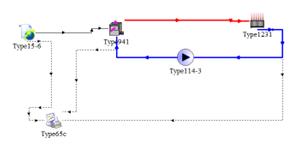
Figure 8. The non-hybrid system built for the TRNSYS simulation
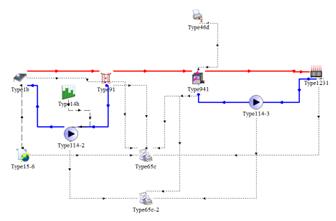
Figure 9. The hybrid system built for the TRNSYS simulation
For the purposes of the simulation, the system was simplified by removing the heat storage tank. Evaluating the inlet and outlet temperature of the radiator was prioritized so the intermediate stage of the heat storage tank could be removed without affecting the metrics investigated. A control function to the solar thermal collector cycle was added to regulate the system; under the forcing function, the solar thermal collector operates between 08:00 and 18:00 daily, ceasing to work during the night. This simulates anticipated usage patterns where the hybrid system operates during the day, storing the heat generated in the tank to be used during the night.
The novel coupling design was simulated using a heat exchanger that connects the temperature of the source-side liquid to the temperature of the inlet air to the evaporator of the ASHP. Realistically, the heat transfer at this stage would be much smaller than a direct exchange, so the heat exchanger effectiveness was adjusted to 0.1 to factor in the loss of thermal energy in our prototype.
3. Results
3.1. Overview of Experimental Data
Three sets of data were collected at different ambient temperatures. Each set includes data collected from testing the system in hybrid and non-hybrid modes at a particular ambient temperature.
Table 3. Overview of experiment results from the different sets collected
| Set | Mode | Ambient Temperature (°C) | Rate of Temperature Increase (°C/s) | Average COP |
| 1 | Non-hybrid | 13 | 0.001189 | 7.99 |
| Hybrid | 13 | 0.002022 | 6.18 | |
| 2 | Non-hybrid | 17 | 0.002878 | 7.11 |
| Hybrid | 17 | 0.003615 | 6.32 | |
| 3 | Non-hybrid | 20 | 0.003627 | 7.19 |
| Hybrid | 20 | 0.004273 | 5.73 |
3.2. Heating Rate
The time taken for the heat storage tank temperature to increase from 35°C to 50°C and the rates of temperature increase (°C/s) for the different operating modes and ambient temperatures are given below:
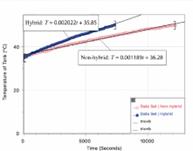
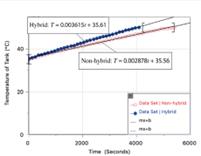
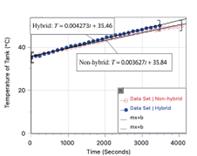
Figure 10. The heating rate achieved by the hybrid and non-hybrid systems at ambient temperatures of A: 13°C; B: 17°C; C: 20°C
At an ambient temperature of 13°C, the system took 7320 seconds in hybrid mode and 12240 seconds in non-hybrid mode for the temperature of the heat storage tank to increase from 35°C to 50°C. When the ambient temperature was 17°C, the system took 4080 seconds in hybrid mode and 5400 seconds in non-hybrid mode; at 20°C, it took 3480 and 4080 seconds respectively (Figure 10).
The corresponding rates of temperature increase were obtained from the gradients of the linear functions; a comparison of these rates is shown below:
As anticipated, as the ambient temperature decreases, the rate at which the system heats the heat storage tank decreases – the temperature of the ASHP’s air source is lower, leading to less thermal energy obtained for the ASHP; hence, for the same change in temperature, a longer time is required. However, we notice that the system in hybrid mode can heat the water in the tank from 35°C to 50°C in less time than the system in non-hybrid mode under all ambient temperatures (Figure 11). The percentage improvement in the rate of temperature increase becomes more pronounced as the ambient temperature reduces: at 20°C, the rate was 17.8% higher in hybrid mode, increasing to 25.6% higher at an ambient temperature of 17°C, finally reaching a maximum value at 13°C, the lowest ambient temperature tested, with a significant 70.1% increase (Figure 12).
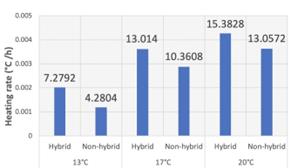 | 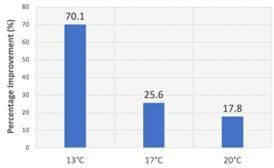 |
Figure 11. Comparison of the heating rates achieved by the hybrid and non-hybrid systems at different ambient temperatures (°C/h) | Figure 12. Percentage improvement of the hybrid system’s heating rate over non-hybrid at different ambient temperatures |
This is illustrated by the notable reduction of heating times at 13°C, where the system in hybrid mode was able to save 4920 seconds (82 minutes) compared to the system in non-hybrid mode. The hybrid system had superior heating performance under all ambient temperatures. These results exemplify the improved performance and efficiency generated by having a second energy source, validating and confirming the advantages of the unique coupling design adopted in the novel hybrid ST-ASHP system.
3.3. Impact of the Solar Thermal Collector
The amount of energy supplied by the solar thermal collector increased with ambient temperature. At 13°C, there were the most fluctuations in the energy supplied by the solar thermal collector per second, with most values ranging between 200J and 300J. At an ambient temperature of 17°C, most values ranged from 300J to 400J. At 20°C, all values were above 400J, with over half falling between 500J and 600J (Figure 13). This confirmed prior observations that the novel hybrid ST-ASHP system heats the heat storage tank more rapidly at higher ambient temperatures, as the solar thermal collector is able to supply more energy to the ASHP by heating the water to a higher temperature.

Figure 13. The energy supplied by the solar thermal collector of the hybrid system at ambient temperatures of A: 13°C; B: 17°C; C: 20°C
However, it appeared that the impact of the solar thermal collector is felt most strongly at lower ambient temperatures; although the solar thermal collector supplies less energy at these temperatures, it is responsible for differentiating the performance of the hybrid system from a single-source system by improving the heat gain at the evaporator of the ASHP. Furthermore, this additional thermal energy also serves an important role in reducing the risk of frost accumulation on the ASHP evaporator in the heat exchanger by increasing the surface temperature of the evaporator coils.
3.4. Instantaneous and Average COP of the System
The following graphs show how instantaneous COP varies for systems in non-hybrid and hybrid modes at the three ambient temperatures tested:
The instantaneous COP of the systems appear to exhibit increasing trends over time, illustrated more clearly at higher ambient temperatures. This is because the inlet temperature of the radiator increases more than the room temperature, so heat transfer from the radiator to the room is greater. At each ambient temperature, the instantaneous COP is slightly higher for non-hybrid mode compared to hybrid mode (Figure 14). This is to be expected as the hybrid system involved an additional pump for the solar thermal collector cycle.

Figure 14. Instantaneous COP of the hybrid (blue) and non-hybrid (orange) systems at ambient temperatures of A: 13°C; B: 17°C; C: 20°C
The average COP values are calculated by taking the integral of power input and power output. The average COP also indicates that the non-hybrid system has a higher COP under all ambient temperatures tested. The average COP does not show a clear trend with ambient temperature; experiment results show that it falls between 5.5 and 6.5 when the system is in hybrid mode and between 7 and 8 when it is in non-hybrid mode (Figure 15). Nonetheless, the hybrid system was still able to achieve a high COP value (twice the 2.3-3.5 range for most air-conditioning units), and its superior heating performance compared to the single-source ASHP compensates for the lower COP value.
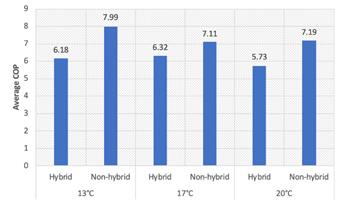
Figure 15. Average COP of the hybrid and non-hybrid systems at different ambient temperatures
3.5. TRNSYS Simulation Results
TRNSYS simulations were developed for the novel ST-ASHP system to evaluate its applicability in a range of climates. These simulations are based on the prototype system explored in section 2.2, with minor adjustments to ensure compatibility with the TRNSYS software. Two models were built in TRNSYS to simulate the hybrid and non-hybrid working modes of the heating system.
Four Chinese cities (Shanghai, Guilin, Beijing, and Shenyang) covering diverse geographical and climatic regions were selected for the simulation study to evaluate the applicability of the novel hybrid ST-ASHP system in a range of environments. Simulation results are given in Figures 16-19. See Table 4 and Table 5 for the keys of the TRNSYS simulation graphs:
Table 4. Key for all TRNSYS graphs for hybrid systems
Label | Color | Notes |
T Ambient | Red | Ambient temperature, from the Meteonorm file for each city |
T Source In | Blue | Temperature of the source-side inlet of the heat exchanger |
T Source Out | Pink | Temperature of the source-side outlet of the heat exchanger |
T Rad In | Orange | Temperature of the inlet of the radiator |
T Rad Out | Green | Temperature of the outlet of the radiator |
Table 5. Key for all TRNSYS graphs for non-hybrid systems
\table7 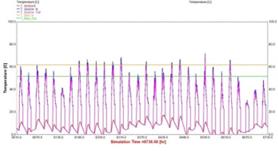 | 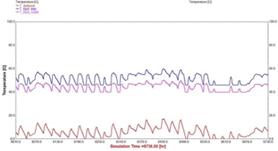 |
Figure 16. Simulation results of two models in Shanghai (left: hybrid, right: non-hybrid) | |
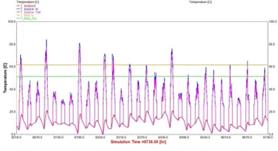 | 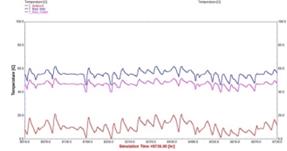 |
Figure 17. Simulation results of two models in Guilin (left: hybrid, right: non-hybrid) | |
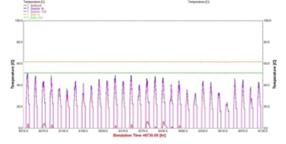 | 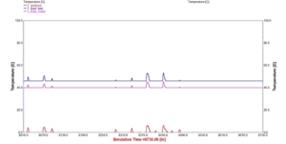 |
Figure 18. Simulation results of two models in Beijing (left: hybrid, right: non-hybrid) | |
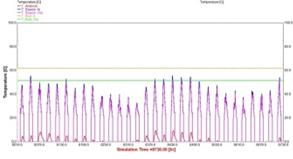 | 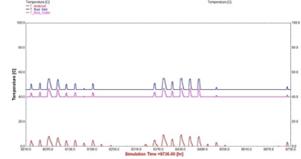 |
Figure 19. Simulation results of two models in Shenyang (left: hybrid, right: non-hybrid) | |
The hybrid system performs very consistently in all climatic conditions simulated, maintaining a radiator inlet temperature above 60°C and a radiator outlet temperature above 50°C; a temperature difference of 10°C between the inlet and outlet is sustained throughout. We notice that the temperature of the radiator inlet and outlet for the hybrid systems does not fluctuate over time and is unaffected by changes in the ambient temperature; this holds even in Beijing and Shenyang, where temperatures are sub-zero for significant periods of the simulation (Figure 18 and Figure 19).
In comparison, the temperature of the radiator inlet and outlet for the non-hybrid system fluctuates significantly with ambient temperature. Generally, the simulations above demonstrate that this relationship is positive, with increases in ambient temperature generally leading to higher inlet and outlet temperatures. However, as the changes in inlet temperature are largely mirrored by similar changes in outlet temperature, the temperature difference between the two for non-hybrid systems is still relatively stable between 5°C and 8°C. Shenyang and Beijing, with the lowest ambient temperatures, have the smallest temperature difference of slightly above 5°C, whereas Guilin, with the highest ambient temperature of the four cities simulated, had the greatest temperature difference of around 8°C (Figure 17, Figure 18, and Figure 19). Nonetheless, these are all smaller than the 10°C temperature difference maintained by the hybrid system. A greater temperature difference indicates a greater power output. Hence, the results of the simulation suggest that the hybrid system is able to perform consistently and reliably under a range of climatic conditions, achieve greater power output, and has the potential to be utilized in both Southern and Northern Chinese cities.
4. Discussion
4.1. Theoretical analysis
The experimental test of the prototype and TRNSYS simulations demonstrated that the innovative coupling design of the novel hybrid system optimizes ASHP performance. This is evidenced by the superior heating rate of the novel hybrid system over conventional single-source ASHP at all ambient temperatures tested, with especially pronounced improvements at low ambient temperatures. These results support the hypothesis, as they suggest that the additional solar thermal energy supplied to the air source in the heat exchanger was responsible for the improved heating performance of the novel hybrid system. Furthermore, the high COP values achieved by the novel hybrid system indicates its environmental sustainability.
The novel hybrid system effectively addressed the two major concerns associated with current single-source ASHP. It is able to enhance ASHP performance significantly in low ambient temperatures by virtue of its novel coupling design. The air source temperature is raised by supplementary thermal energy from the solar thermal collector, allowing the ASHP to extract more heat to transfer indoors. Additionally, the surface temperature of the ASHP evaporator on the load-side of the heat exchanger is also increased, reducing the risk of frost accumulation.
Compared to parallel configurations explored in previous studies, the innovative serial configuration adopted in the novel hybrid system effectively addresses the primary concern facing ASHP – low air source temperature. Aside from the versatility hybrid sources offer, this design maximizes the synergistic effects of the two sources by allowing the solar thermal collector to increase the air source temperature for the ASHP. In parallel systems, the ASHP is still negatively impacted by low air source temperature because the supplemental energy from the solar thermal collector is separately linked to the tank and cannot increase the air source temperature of the ASHP.
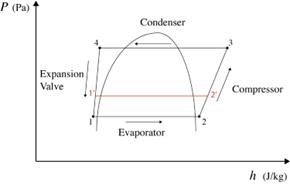
Figure 21. Pressure-enthalpy diagram for the ASHP. 1’-2’ represents the evaporating pressure in the hybrid system
Theoretically, the substantial improvements in heating rate can be explained by analyzing a pressure-enthalpy diagram. The additional energy supplied by the solar thermal collector increases the evaporation pressure (Figure 21). This increases the density of the working fluid, meaning for the same rotational speed of the compressor and volumetric flow rate, the mass flow rate increases. Hence, more thermal energy is supplied, and the heating capacity of the ASHP increases. The comparative advantage of the hybrid system increases as the evaporation pressure reduces with ambient temperature; therefore, the increase in evaporation pressure is greater when the hybrid system is used in lower ambient temperatures, making its effects more obvious.
The performance of hybrid and non-hybrid systems could only be compared if they operated under the same ambient temperature to ensure a fair test. However, it was impossible to control the ambient temperature between experiments. Ultimately, multiple sets had to be collected, and those with similar ambient temperatures were selected for comparison. Other variables, like moisture, could not be controlled but may have an impact on the results. These inherent limitations of the experiment were addressed through simulations on TRNSYS that allowed a wide range of environmental factors to be controlled.
4.2. Socio-economic analysis
Estimations were made to evaluate the social impacts of the novel hybrid heat pump. Assuming that a household currently owns two air conditioning units with a 1000 W power rating each, the total energy cost is roughly 488 RMB. Using the 1:2 ratio between the COP of air conditioning units and the novel hybrid heat pump, we find that the novel hybrid heat pump can save 244 RMB per month, amounting to 976 RMB over the four-month heating period determined through the survey research.
Air conditioning units use an average of 1440 kWh of electricity over one heating period; again, as the novel hybrid system is twice as efficient, it only uses 720 kWh over this same period. Each kWh of electricity roughly corresponds to 0.82 kg of CO2 emissions; hence, each family could reduce their carbon footprint by over 590 kg every winter. For the total of 8 million families in Shanghai, 47 million kg of CO2 can be saved per year in CO2 emissions from heating. While these calculations are preliminary and based off assumptions, they indicate the socio-economic viability of the novel hybrid heat pump.
5. Conclusions
In this study, an innovative hybrid solar-assisted air source heat pump was designed and constructed to address the limitations of singles-source air source heat pumps. The novel system was evaluated through prototype experimentation and numerical simulation. The main conclusions of the research are as follows:
1. The novel hybrid system was found to have superior heating performance compared to traditional non-hybrid air source heat pumps, with especially pronounced advantages in low ambient temperatures. At 13°C, it achieved a heating rate 70.1% higher than the non-hybrid system. This suggests the efficacy of the innovative coupling design that improved thermal energy gains from the air source for the novel hybrid system.
2. The novel hybrid system achieved high average COP ratings between 5.7 and 6.3, significantly higher than the 2.3-3.5 COP ratings for most air conditioning units. Hence, the novel hybrid system demonstrates its potential as a renewable and efficient heat method. Using the ratio between the COP ratings of the novel hybrid system and air conditioning units, rough estimates suggest that the novel hybrid system can save around 1000 RMB in energy costs for an average Shanghai family per year and reduce CO2 emissions by up to 4.7 million tons if it sees widespread application
3. TRNSYS simulations indicate that the novel hybrid system enjoyed consistently high performance under a variety of ambient temperatures and climatic conditions; this offers a marked improvement over traditional single-source ASHP systems that see fluctuations in performance.
Although the study demonstrates the technological viability of the concept of a novel hybrid solar-assisted ASHP, there are certain limitations in the study that could be addressed in future work:
(1) For safety reasons, the temperature range of the storage tank can only be set to 35-50°C. Although this does not affect the conclusion, in real situation however, considering heat losses or heat efficiency of the entire system, the temperature range can be set to higher levels (for example 35-70 °C) in future research.
4. Second, the selection of the testing equipment and the design of the system is a little bulky at this stage. This is mainly due to local availability, cost, and experimental time pressure. With careful selection of system components, a more compact design can be achieved to improve installation flexibility. The specific installation of the prototype system in urban renewal contexts could be investigated through modelling with Sketchup and AutoCAD; general strategies can be developed for vernacular housing in Shanghai.
5. Future research could focus on further improving the COP of hybrid heating systems like the novel ST-ASHP; in particular, the solar thermal collector of the system may be designed to track the sun, thereby maximizing the thermal energy gains from solar irradiation.
Although further research is needed to optimize the system design, current research demonstrated clearly that the novel hybrid system is an efficient, cost-effective, and sustainable system for urban renewal.
References
[1]. Hall, Casey. Why Shanghai’s oldest neighbourhood has to shiver each winter. (2018, January 4). South China Morning Post. https://www.scmp.com/news/china/society/article/2126825/why-shanghais-oldest-neighbourhood-has-shiver-each-year-through
[2]. Nie, Y., Bu, Z., & Yang, J. (2017). Discussion on heating strategies in winter of residential buildings in Shanghai aiming at ultra-low energy target. Procedia Engineering, 205, 3130–3137.
[3]. Environment, U. N. (2022, November 9). 2022 Global Status Report for Buildings and Construction. UNEP - UN Environment Programme. https://www.unep.org/resources/publication/2022-global-status-report-buildings-and-construction
[4]. CO2 emissions from buildings and construction hit new high, leaving sector off track to decarbonize by 2050: UN. (2022, November 9). UN Environment. http://www.unep.org/news-and-stories/press-release/co2-emissions-buildings-and-construction-hit-new-high-leaving-sector
[5]. Heat Pumps - Energy System. IEA. https://www.iea.org/energy-system/buildings/heat-pumps
[6]. Wang, X., Xia, L., Bales, C., Zhang, X., Copertaro, B., Pan, S., & Wu, J. (2020). A systematic review of recent air source heat pump (ASHP) systems assisted by solar thermal, photovoltaic and photovoltaic/thermal sources. Renewable Energy, 146, 2472–2487. https://doi.org/10.1016/j.renene.2019.08.096
[7]. Research shows huge heat pump potential in china. (n.d.). CLASP. Retrieved 23 December 2023, from https://www.clasp.ngo/updates/research-shows-huge-heat-pump-potential-in-china/
[8]. https://doi.org/10.1016/j.proeng.2017.10.134
[9]. Cai, J., Zhou, H., Xu, L., Shi, Z., Zhang, T., & Ji, J. (2022). Energy and exergy analysis of a novel solar-air composite source multi-functional heat pump. Renewable Energy, 185, 32–46. https://doi.org/10.1016/j.renene.2021.12.033
[10]. Song, M., Deng, S., Dang, C., Mao, N., & Wang, Z. (2018). Review on improvement for air source heat pump units during frosting and defrosting. Applied Energy, 211, 1150–1170. https://doi.org/10.1016/j.apenergy.2017.12.022
[11]. Patil, M. S., Seo, J.-H., & Lee, M.-Y. (2017). Heat transfer characteristics of the heat exchangers for refrigeration, air conditioning and heat pump systems under frosting, defrosting and dry/wet conditions—A review. Applied Thermal Engineering, 113, 1071–1087. https://doi.org/10.1016/j.applthermaleng.2016.11.107
[12]. Wen, B. (2018). Winter heating in Shanghai.Mechanical and Electrical Information, 546, 146-147.
[13]. Solar water heaters. (n.d.). Energy.Gov. Retrieved 23 December 2023, from https://www.energy.gov/energysaver/solar-water-heaters
[14]. Jouhri, M., Dhakar, P. (2019). A Review Study on Solar Water Heating Systems. Journal of Emerging Technologies and Innovative Research. https://www.researchgate.net/publication/345002100_A_Review_Study_on_Solar_Water_Heating_Systems
[15]. Dong, S., Xu, T., & Chen, M. (2022). Solar radiation characteristics in shanghai. Journal of Physics: Conference Series, 2351(1), 012016. https://doi.org/10.1088/1742-6596/2351/1/012016
[16]. Liu, Y., Zhang, H., & Chen, H. (2020). Experimental study of an indirect-expansion heat pump system based on solar low-concentrating photovoltaic/thermal collectors. Renewable Energy, 157, 718–730. https://doi.org/10.1016/j.renene.2020.05.090
[17]. Yerdesh, Ye., Abdulina, Z., Aliuly, A., Belyayev, Ye., Mohanraj, M., & Kaltayev, A. (2020). Numerical simulation on solar collector and cascade heat pump combi water heating systems in Kazakhstan climates. Renewable Energy, 145, 1222–1234. https://doi.org/10.1016/j.renene.2019.06.102
[18]. Esfandeh, S., Hemmat Esfe, M., & Kamyab, M. H. (2022). Chapter 11—Applications of nanofluids in solar energy collectors focusing on solar stills. In H. M. Ali (Ed.), Advances in Nanofluid Heat Transfer (pp. 341–373). Elsevier. https://doi.org/10.1016/B978-0-323-88656-7.00010-6
[19]. Yao, J., Chen, E., Dai, Y., & Huang, M. (2020). Theoretical analysis on efficiency factor of direct expansion PVT module for heat pump application. Solar Energy, 206, 677–694. https://doi.org/10.1016/j.solener.2020.04.053
Cite this article
Gan,M. (2024). A novel solar-assisted air source heat pump system for urban renewal: Experimental test and numerical simulation. Applied and Computational Engineering,91,116-130.
Data availability
The datasets used and/or analyzed during the current study will be available from the authors upon reasonable request.
Disclaimer/Publisher's Note
The statements, opinions and data contained in all publications are solely those of the individual author(s) and contributor(s) and not of EWA Publishing and/or the editor(s). EWA Publishing and/or the editor(s) disclaim responsibility for any injury to people or property resulting from any ideas, methods, instructions or products referred to in the content.
About volume
Volume title: Proceedings of the 2nd International Conference on Functional Materials and Civil Engineering
© 2024 by the author(s). Licensee EWA Publishing, Oxford, UK. This article is an open access article distributed under the terms and
conditions of the Creative Commons Attribution (CC BY) license. Authors who
publish this series agree to the following terms:
1. Authors retain copyright and grant the series right of first publication with the work simultaneously licensed under a Creative Commons
Attribution License that allows others to share the work with an acknowledgment of the work's authorship and initial publication in this
series.
2. Authors are able to enter into separate, additional contractual arrangements for the non-exclusive distribution of the series's published
version of the work (e.g., post it to an institutional repository or publish it in a book), with an acknowledgment of its initial
publication in this series.
3. Authors are permitted and encouraged to post their work online (e.g., in institutional repositories or on their website) prior to and
during the submission process, as it can lead to productive exchanges, as well as earlier and greater citation of published work (See
Open access policy for details).
References
[1]. Hall, Casey. Why Shanghai’s oldest neighbourhood has to shiver each winter. (2018, January 4). South China Morning Post. https://www.scmp.com/news/china/society/article/2126825/why-shanghais-oldest-neighbourhood-has-shiver-each-year-through
[2]. Nie, Y., Bu, Z., & Yang, J. (2017). Discussion on heating strategies in winter of residential buildings in Shanghai aiming at ultra-low energy target. Procedia Engineering, 205, 3130–3137.
[3]. Environment, U. N. (2022, November 9). 2022 Global Status Report for Buildings and Construction. UNEP - UN Environment Programme. https://www.unep.org/resources/publication/2022-global-status-report-buildings-and-construction
[4]. CO2 emissions from buildings and construction hit new high, leaving sector off track to decarbonize by 2050: UN. (2022, November 9). UN Environment. http://www.unep.org/news-and-stories/press-release/co2-emissions-buildings-and-construction-hit-new-high-leaving-sector
[5]. Heat Pumps - Energy System. IEA. https://www.iea.org/energy-system/buildings/heat-pumps
[6]. Wang, X., Xia, L., Bales, C., Zhang, X., Copertaro, B., Pan, S., & Wu, J. (2020). A systematic review of recent air source heat pump (ASHP) systems assisted by solar thermal, photovoltaic and photovoltaic/thermal sources. Renewable Energy, 146, 2472–2487. https://doi.org/10.1016/j.renene.2019.08.096
[7]. Research shows huge heat pump potential in china. (n.d.). CLASP. Retrieved 23 December 2023, from https://www.clasp.ngo/updates/research-shows-huge-heat-pump-potential-in-china/
[8]. https://doi.org/10.1016/j.proeng.2017.10.134
[9]. Cai, J., Zhou, H., Xu, L., Shi, Z., Zhang, T., & Ji, J. (2022). Energy and exergy analysis of a novel solar-air composite source multi-functional heat pump. Renewable Energy, 185, 32–46. https://doi.org/10.1016/j.renene.2021.12.033
[10]. Song, M., Deng, S., Dang, C., Mao, N., & Wang, Z. (2018). Review on improvement for air source heat pump units during frosting and defrosting. Applied Energy, 211, 1150–1170. https://doi.org/10.1016/j.apenergy.2017.12.022
[11]. Patil, M. S., Seo, J.-H., & Lee, M.-Y. (2017). Heat transfer characteristics of the heat exchangers for refrigeration, air conditioning and heat pump systems under frosting, defrosting and dry/wet conditions—A review. Applied Thermal Engineering, 113, 1071–1087. https://doi.org/10.1016/j.applthermaleng.2016.11.107
[12]. Wen, B. (2018). Winter heating in Shanghai.Mechanical and Electrical Information, 546, 146-147.
[13]. Solar water heaters. (n.d.). Energy.Gov. Retrieved 23 December 2023, from https://www.energy.gov/energysaver/solar-water-heaters
[14]. Jouhri, M., Dhakar, P. (2019). A Review Study on Solar Water Heating Systems. Journal of Emerging Technologies and Innovative Research. https://www.researchgate.net/publication/345002100_A_Review_Study_on_Solar_Water_Heating_Systems
[15]. Dong, S., Xu, T., & Chen, M. (2022). Solar radiation characteristics in shanghai. Journal of Physics: Conference Series, 2351(1), 012016. https://doi.org/10.1088/1742-6596/2351/1/012016
[16]. Liu, Y., Zhang, H., & Chen, H. (2020). Experimental study of an indirect-expansion heat pump system based on solar low-concentrating photovoltaic/thermal collectors. Renewable Energy, 157, 718–730. https://doi.org/10.1016/j.renene.2020.05.090
[17]. Yerdesh, Ye., Abdulina, Z., Aliuly, A., Belyayev, Ye., Mohanraj, M., & Kaltayev, A. (2020). Numerical simulation on solar collector and cascade heat pump combi water heating systems in Kazakhstan climates. Renewable Energy, 145, 1222–1234. https://doi.org/10.1016/j.renene.2019.06.102
[18]. Esfandeh, S., Hemmat Esfe, M., & Kamyab, M. H. (2022). Chapter 11—Applications of nanofluids in solar energy collectors focusing on solar stills. In H. M. Ali (Ed.), Advances in Nanofluid Heat Transfer (pp. 341–373). Elsevier. https://doi.org/10.1016/B978-0-323-88656-7.00010-6
[19]. Yao, J., Chen, E., Dai, Y., & Huang, M. (2020). Theoretical analysis on efficiency factor of direct expansion PVT module for heat pump application. Solar Energy, 206, 677–694. https://doi.org/10.1016/j.solener.2020.04.053









